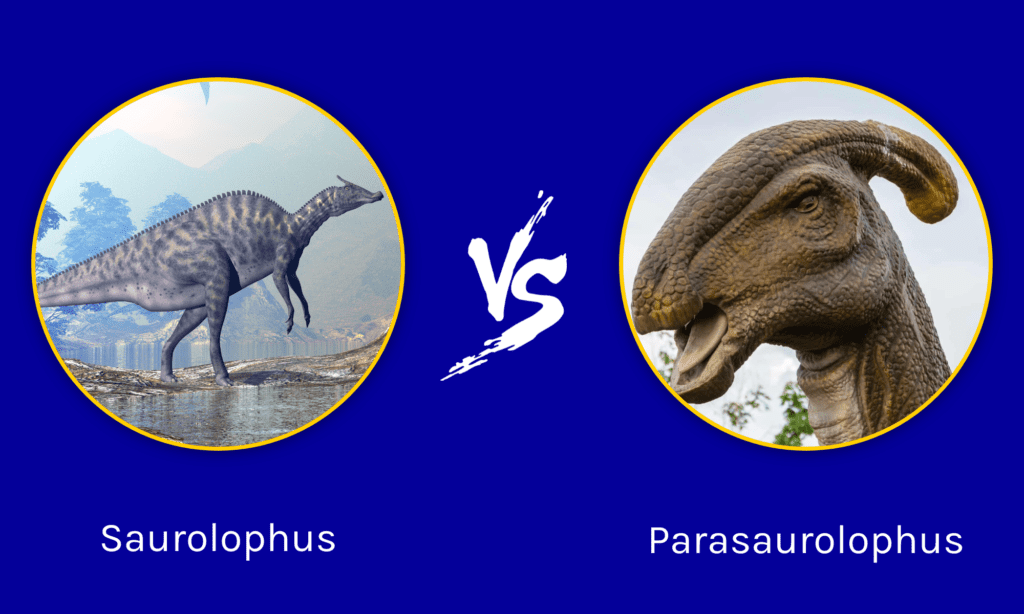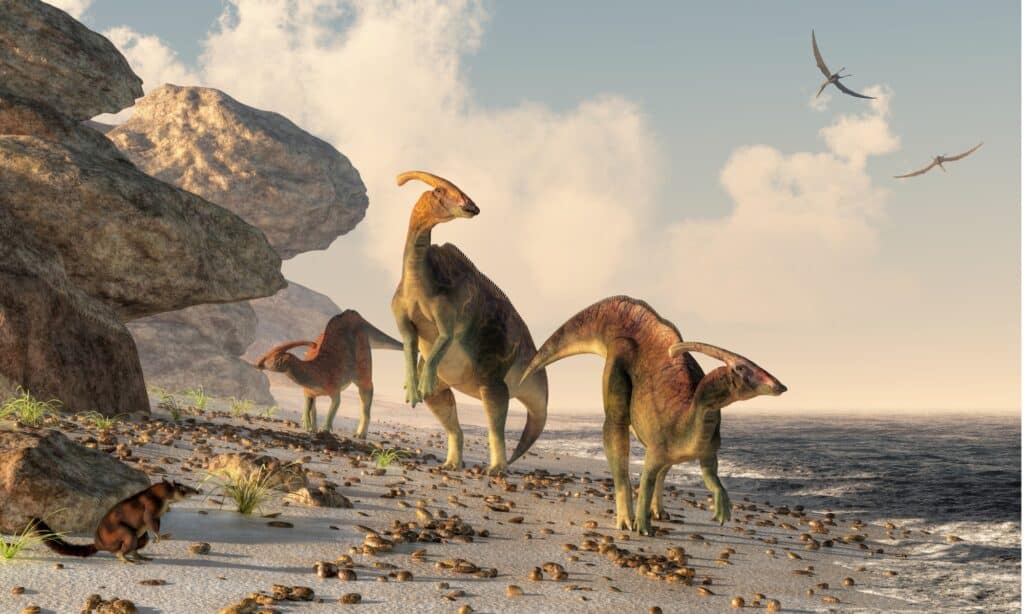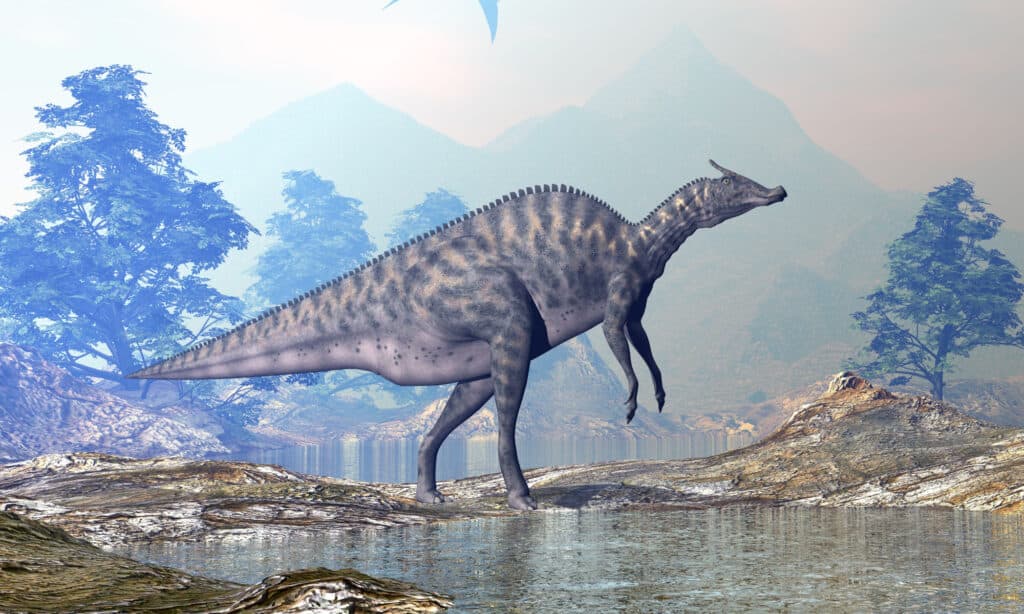Although T-rex and Velociraptor may be some of the more interesting dinosaurs, other important reptiles existed. In fact, some of them were not apex predators. Instead, they were herbivores. Today, we’re going to examine Saurolophus vs Parasaurolophus. We’ll tell you the differences between these dinosaurs and talk about the cranial crests that make them so unique.
Comparing a Saurolophus and a Parasaurolophus

| Saurlophus | Paraasaurolophus | |
|---|---|---|
| Size | Weight: 4,200-6,600 lbs Height: 6-12 ft Length: 20-27 ft | Weight: 4,000-5,600 lbs (possibly up to 8,000 lbs) Height: 12-16ft Length: 25-31ft |
| Morphology | – Cranial crest extending back from its head in a rounded triangular shape – Small head leading from a short, thick neck – Very thick body – Both bipedal and quadrupedal with smaller forelegs | – Large cranial crest that arched over the back of the skull with many potential uses including identification, making sounds, and more – Duck-billed dinosaur – Both bipedal and quadrupedal – Smaller forelegs that could help the animal walk on – Thick body – Skin frill on its back |
| Species | – Saurolophus osborni – Saurolophus angustirostris | – Parasaurolophus cyrtocristatus – Parasaurolophus tubicen – Parasaurolophus walkeri |
| Location | – Asia and North America | North America and maybe China |
| Era | – 70 million to 68 million years ago | 76-74 million years ago |
The Key Differences Between a Saurolophus vs Parasaurolophus

Parasaurolophus had a larger crest and lived at a different time than Saurolophus.
©iStock.com/Daniel Eskridge
The biggest differences between a Saurolophus and a Parasaurolophus are their size and the era in which they lived. The Saurolophus was an herbivorous biped and quadruped that lived 68 million years ago, stood 12 feet tall, weighed 6,600 pounds, and grew 27 ft long. Parasaurolophus was an herbivorous biped and quadrupedal dinosaur that lived 73 million years ago, weighed 8,000 pounds, stood 16 feet high, and measured 31 feet long.
As you can see, some of the differences between these dinosaurs are very pronounced. Some of their other qualities are not that different. We’ll go into greater depth regarding both creatures in the following sections.
Saurolophus vs Parasaurolophus: Size

Saurolophus was smaller than Parasaurolophus.
©Elenarts/Shutterstock.com
Parasaurolophus was larger than Saurolophus. The Parasaurolophus weighed up to 8,000 pounds, stood 16 feet tall, and measured 31 feet long. The Saurolophus only weighed about 6,600 pounds at its maximum, stood maybe 12 feet tall, and grew up to 27 feet long. The size difference is not vast between these two creatures, but it is rather noticeable.
Saurolophus vs Parasaurolophus: Morphology
The greatest series of differences between the Saurolophus and Parasaurolophus lies in their morphology. On the surface, both creatures were remarkably similar. After all, they were both hadrosaurid dinosaurs that were bipedal as well as quadrupedal.
These dinosaurs both had a pair of smaller, thinner forelegs that they could use to walk on or to prop them up while they ate vegetation. Also, both dinosaurs had crests that they probably used to make sounds to communicate with the rest of their herd.
Saurolophus had a crest that extended from the back of its head and had a rounded triangular shape. However, Parasaurolophus had a crest that curved toward the back of its head and extended far past the end of the skull.
Another interesting similarity between these dinosaurs is their very thick bodies. They were very bulky through the midsection. Despite not being very tall or very long, they were heavy. Also, both creatures had a head that was very small relative to their total body size.
Scientists can support these observations and reconstructions since extensive fossil records of both dinosaurs have been recovered.
Saurolophus vs Parasaurolophus: Species
Both the Saurolophus and Parasaurolophus have a few species. The Saurolophus has two species called Saurolophus osborni and Saurolophus angustirostris. Meanwhile, Parasaurolophus has three species that are called Parasaurolophus cyrtocristatus, Parasaurolophus tubicen, and Parasaurolophus walker.
This is a rather small difference in the grand scheme of things, but it is worth noting.
Saurolophus vs Parasaurolophus: Location
The Saurolophus fossils were found in North America and Asia. Specifically, they were found in Canada and Mongolia. Yet, Parasaurolophus has also been found in Asia and North America. These fossils were discovered in the United States, Canada, and possibly China.
These two species of dinosaurs were found in similar areas to one another, but their ranges didn’t perfectly overlap.
Saurolophus vs Parasaurolophus: Era
The Saurolophus lived in the Late Cretaceous period. It’s believed that these dinosaurs lived between 70 and 68 million years ago. That means these dinosaurs went extinct shortly before the asteroid impact that ended the dinosaurs.
The Parasaurolophus also lived during the Late Cretaceous period. Scientists believe that these dinosaurs lived between 76 and 74 million years ago. That means they were probably already extinct by the time that the Saurolophus appeared.
So, both dinosaurs lived in the same era, but they also lived millions of years apart from each other. At least, that’s the current estimate for them.
Saurolophus vs Parasaurolophus: Who Would Win in a Fight?

A Parasaurolophus would win a fight against a Saurolophus. The Parasaurolophus was much bigger and probably more powerful than the Saurolophus. As a result, it’s hard to imagine that the smaller dinosaur could manage to kill the larger one.
In the fight, the two animals would rely on their size to issue a killing blow, probably with some combination of their heads, tails, and feet. Ultimately, the dinosaurs would probably have to knock over their opponent and then stomp it to death.
Based on that evaluation of a fight between the two herbivores, the Parasaurolophus would be the one standing on the crumpled form of the Saurolophus.
However, this fight would probably not happen for many reasons, the least of which are the time and space separating the species. These dinosaurs were herbivores. The last thing they wanted to do would be to get involved in a fight with another dinosaur.
They were poorly equipped to do much more than flee from larger carnivores like T-rex, Giganotosaurus, or Spinosaurus. These dinosaurs might try to charge and scare off the other one, but that would probably be the extent of a battle between them.
The photo featured at the top of this post is © Daniel Eskridge/Shutterstock.com
Thank you for reading! Have some feedback for us? Contact the AZ Animals editorial team.






